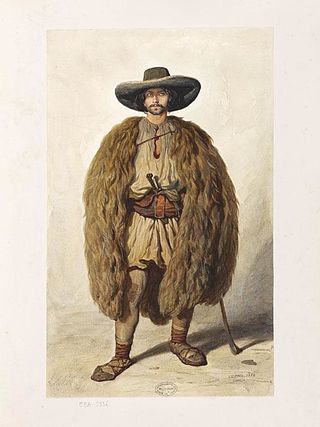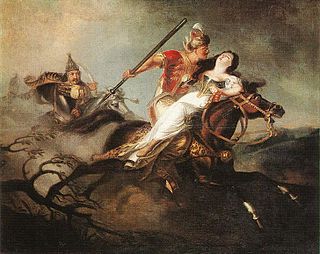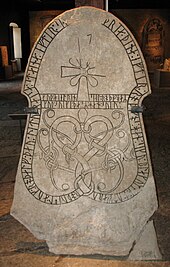Kaloyan or Kalojan, also known as Ivan I, Ioannitsa or Johannitsa, the Romanslayer, was emperor or tsar of Bulgaria from 1196 to 1207. He was the younger brother of Theodor and Asen, who led the anti-Byzantine uprising of the Bulgarians and Vlachs in 1185. The uprising ended with the restoration of Bulgaria as an independent state. He spent a few years as a hostage in Constantinople in the late 1180s. Theodor, crowned Emperor Peter II, made him his co-ruler after Asen was murdered in 1196. A year later, Peter was also murdered, and Kaloyan became the sole ruler of Bulgaria.

Vlach, also Wallachian, is a term and exonym used from the Middle Ages until the Modern Era to designate speakers of Eastern Romance languages living in Southeast Europe—south of the Danube and north of the Danube.
Several theories, in great extent mutually exclusive, address the issue of the origin of the Romanians. The Romanian language descends from the Vulgar Latin dialects spoken in the Roman provinces north of the "Jireček Line" in Late Antiquity. The theory of Daco-Roman continuity argues that the Romanians are mainly descended from the Daco-Romans, a people developing through the cohabitation of the native Dacians and the Roman colonists in the province of Dacia Traiana north of the river Danube. The competing immigrationist theory states that the Romanians' ethnogenesis commenced in the provinces south of the river with Romanized local populations spreading through mountain refuges, both south to Greece and north through the Carpathian Mountains. Other theories state that the Romanized local populations were present over a wide area on both sides of the Danube and the river itself did not constitute an obstacle to permanent exchanges in both directions; according to the "admigration" theory, migrations from the Balkan Peninsula to the lands north of the Danube contributed to the survival of the Romance-speaking population in these territories.

The Pechenegs or Patzinaks were a semi-nomadic Turkic people from Central Asia who spoke the Pecheneg language. In the 9th and 10th centuries, the Pechenegs controlled much of the steppes of southeast Europe and the Crimean Peninsula. In the 9th century the Pechenegs began a period of wars against Kievan Rus', and for more than two centuries launched raids into the lands of Rus', which sometimes escalated into full-scale wars.

Gesta Hungarorum, or The Deeds of the Hungarians, is the earliest book about Hungarian history which has survived for posterity. Its genre is not chronicle, but gesta, meaning "deeds" or "acts", which is a medieval entertaining literature. It was written in Latin by an unidentified author who has traditionally been called Anonymus in scholarly works. According to most historians, the work was completed between around 1200 and 1230. The Gesta exists in a sole manuscript from the second part of the 13th century, which was for centuries held in Vienna. It is part of the collection of Széchényi National Library in Budapest.

Gelou was the Vlach ruler of Transylvania at the time of the Hungarian conquest of the Carpathian Basin around 900 AD, according to the Gesta Hungarorum. Although the Gesta Hungarorum, which was written after 1150, does not indicate the enemies of the conquering Hungarians (Magyars) known from earlier annals and chronicles, it refers to local rulers—including Gelou—who are not mentioned in other primary sources. Consequently, historians debate whether Gelou was a historical person or an imaginary figure created by the unidentified author of the Gesta Hungarorum. In Romanian historiography, based on the mention of him by Anonymus some 300 years later, Gelou is considered one of three early-10th-century Romanian dukes with lands in the intra-Carpathian region of present-day Romania.

The trade route from the Varangians to the Greeks was a medieval trade route that connected Scandinavia, Kievan Rus' and the Eastern Roman Empire. The route allowed merchants along its length to establish a direct prosperous trade with the Empire, and prompted some of them to settle in the territories of present-day Belarus, Russia and Ukraine. The majority of the route comprised a long-distance waterway, including the Baltic Sea, several rivers flowing into the Baltic Sea, and rivers of the Dnieper river system, with portages on the drainage divides. An alternative route was along the Dniester river with stops on the western shore of Black Sea. These more specific sub-routes are sometimes referred to as the Dnieper trade route and Dniester trade route, respectively.

Glad was the ruler of Banat at the time of the Hungarian conquest of the Carpathian Basin around 900 AD, according to the Gesta Hungarorum. The Gesta, which was written by an author known in modern scholarship as Anonymus in the second half of the 12th century or in the early 13th century, is the earliest extant Hungarian chronicle. The Gesta did not refer to the enemies of the conquering Hungarians, who had been mentioned in earlier annals and chronicles, but wrote of a dozen persons, including Glad, who are unknown from other primary sources of the Hungarian Conquest. Therefore, modern historians debate whether Glad was an actual enemy of the conquerors or only a "fictitious person" made up by Anonymus. In Romanian historiography, based on the mention by Anonymus some 300 years later, Glad is described as one of the three Romanian dukes who ruled a historical region of present-day Romania in the early 10th century.

Ivan Asen I, also known as Asen I or John Asen I, was emperor or tsar of Bulgaria from 1187/1188 to 1196 as co-ruler with his elder brother, Peter II. Hailing from the Byzantine theme of Paristrion, his exact place and date of birth are unknown. Most contemporaneous chronicles describe Asen and his brothers, Theodor (Peter) and Kaloyan, as Vlachs but they were probably of mixed Bulgarian, Cuman and Vlach ancestry.

The Basarabi-Murfatlar Cave Complex is a medieval Christian monastery located near the town of Murfatlar, Constanța County, Northern Dobruja, Romania. The complex is a relict from a widespread monastic phenomenon in 10th century Bulgaria.

Peter II, born Theodor, also known as Theodor-Peter, was the first emperor or tsar of the restored Bulgarian Empire from 1185 to 1197. He hails from the Byzantine theme of Paristrion, although his exact place and date of birth are unknown.
The Early Middle Ages in Romania started with the withdrawal of the Roman troops and administration from Dacia province in the 270s. In the next millennium a series of peoples, most of whom only controlled two or three of the nearly ten historical regions that now form Romania, arrived. During this period, society and culture underwent fundamental changes. Town life came to an end in Dacia with the Roman withdrawal, and in Scythia Minor – the other Roman province in the territory of present-day Romania – 400 years later. Fine vessels made on fast potter's wheels disappeared and hand-made pottery became dominant from the 450s. Burial rites changed more than once from cremation to inhumation and vice versa until inhumation became dominant by the end of the 10th century.
The Roman Catholic Diocese of Cumania was a Latin-rite bishopric west of the Siret River from 1228 to 1241. The lands incorporated into the diocese had been dominated by the nomadic Cumans since about 1100. Catholic missions began after Andrew II of Hungary granted Burzenland to the Teutonic Knights in 1211. After Andrew expelled the Knights from the territory in 1225, Dominican friars continued the Cuman mission. Robert, Archbishop of Esztergom baptized Boricius, an influential Cuman chieftain, two years later.
Boniak, Bonyak or Maniac, also known as Boniak the Mangy, was "one of the most prominent Cuman chieftains" in the late 11th century and the early 12th century. He headed a powerful Cuman tribe or clan that inhabited the steppes to west of the Dnieper River. He supported the Byzantines against the Pechenegs in the Battle of Levounion in 1091. He defeated Coloman, King of Hungary in 1097 or 1099.
This is a timeline of Romanian history, comprising important legal and territorial changes and political events in Romania and its predecessor states. To read about the background to these events, see History of Romania.
The founding of Wallachia, that is the establishment of the first independent Romanian principality, was achieved at the beginning of the 14th century, through the unification of smaller political units that had existed between the Carpathian Mountains, and the Rivers Danube, Siret and Milcov.

The Middle Ages in the Banat started around 900. Around that time, Duke Glad ruled Banat, according to the Gesta Hungarorum. Archaeological finds and 10th-century sources evidence that Magyars settled in the lowlands in the early 10th century, but the survival of Avar, Slav and Bulgar communities can also be documented. A local chieftain, Ajtony, converted to Eastern Orthodoxy around 1000, but his attempts to control the delivery of salt on the Mureș River brought him into conflict with Stephen I of Hungary. Ajtony died fighting against the royal army in the first decades of the 11th century. His realm was transformed into a county of the Kingdom of Hungary. Counties were the most prominent units of royal administration.
The Balkan–Danubian culture was an early medieval archaeological culture which emerged in the region of the Lower Danube in the 8th century and flourished until the 11th century. In Bulgaria it is usually referred to as the Pliska–Preslav culture, while in Romania it is called the Dridu culture. It is better represented in the territory of modern-day Central and Northern Bulgaria, although it probably spread north of the Danube as well due to the continuous extension of the First Bulgarian Empire over the territory of present-day Romania. The Balkan–Danubian culture is described as an early Slavic-Bulgar culture, but besides Slavic and Bulgar elements it also possesses some Romance components. However, this only appears in the southern regions of what is now southern Bulgaria, all of which were heavily influenced by the Byzantine Empire. Famous examples of this architecture are the early Bulgarian capitals of Pliska and Preslav, in addition to the Palace of Omurtag and the Murfatlar Cave Complex. Some scholars partition this culture in two subgroups. Because the Byzantine influence was stronger in the south, the northern finds are entirely Slavic with some Turkic impression.
The Bulaqs were a Turkic tribe known mainly from Arabic sources, originating from the Lop Nor region. They were a core part of the Karluk confederacy located in the Altai Mountains. Many of them migrated to the Southern Ural, into the neighbourhood of the Volga Bulgars and Magna Hungaria Hungarians. Eventually, they were conquered by the Tsardom of Russia in the late 16th century, whom their last record is from.

The Battle of Kerlés also known as the Battle of Cserhalom, was an engagement between an army of Pechenegs and Ouzes commanded by Osul and the troops of King Solomon of Hungary and his cousins, Dukes Géza and Ladislaus, in Transylvania in 1068. The Pechenegs had been the dominant power of the westernmost regions of the Eurasian steppes since around 895. However, large Pecheneg groups moved to the Balkan Peninsula at the same time as the westward migration of the Ouzes and Cumans in the 1040s. The first recorded Pecheneg invasion of Transylvania occurred during the reign of Stephen I of Hungary.










